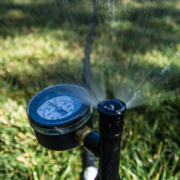Spray irrigation emits water in an overlapping pattern, while drip irrigation delivers water directly to the roots of plants. How do you decide which meets the needs of your landscaping?
The case for spray irrigation
Spray irrigation can be an efficient way to irrigate large landscapes with groundcover or uniform plant materials like lawns or meadows.
Spray systems apply water in gallons per minute (GPM), so if you know the application rate of each spray head, the distance between the heads, and the pressure of your system, it is relatively easy to figure out how much water is applied every time you run your irrigation.
Low volume spray heads apply water at about one-third the rate of conventional spray heads. Newer spray irrigation heads have improved spray with heavier droplets more resistant to wind. Landscaping with grade changes using spray heads should have check valves installed to prevent water flowing out of the lower point heads.
Challenges of spray irrigation include narrow areas surrounded by hardscape, or irregular patterns. Irregular patterns are particularly challenging, because spray irrigation requires head-to-head coverage to be efficient. Odd-shaped areas may be under or over watered. High-volume spray heads that emit water at a much higher rate than soil can absorb should be replaced.
The case for drip irrigation
Drip systems apply water in gallons per hour (GPH), so they often need to run for longer periods of time than spray systems. But the actual run time must always account for precipitation rate and runoff.
Installing subsurface systems (under at least two inches of mulch) is the most efficient way to irrigate nearly every type of garden area. Since the tubing is flexible, it can accommodate a variety of irregular shaped areas or rectangular areas when laid in a grid pattern, and in rings you can easily expand as trees or shrubs grow.
Challenges of drip irrigation include application of water too quickly for your soil to absorb. This needs to be considered when dripline grids are installed. Drip irrigation operates the most efficiently at low pressure (between 15 and 30 PSI). To achieve optimal performance, pressure regulation either at the valve or at the point of connection of the dripline to the buried lateral lines must be used. It is also essential to install some type of filtering system to keep the emitters from getting clogged.
This article was inspired by the 71-page Sustainable Landscapes Program guidebook available at
SustainableLandscapesSD.org. The Water Authority and its partners also offer other great resources for landscaping upgrades, including free WaterSmart classes at
WaterSmartSD.org.



